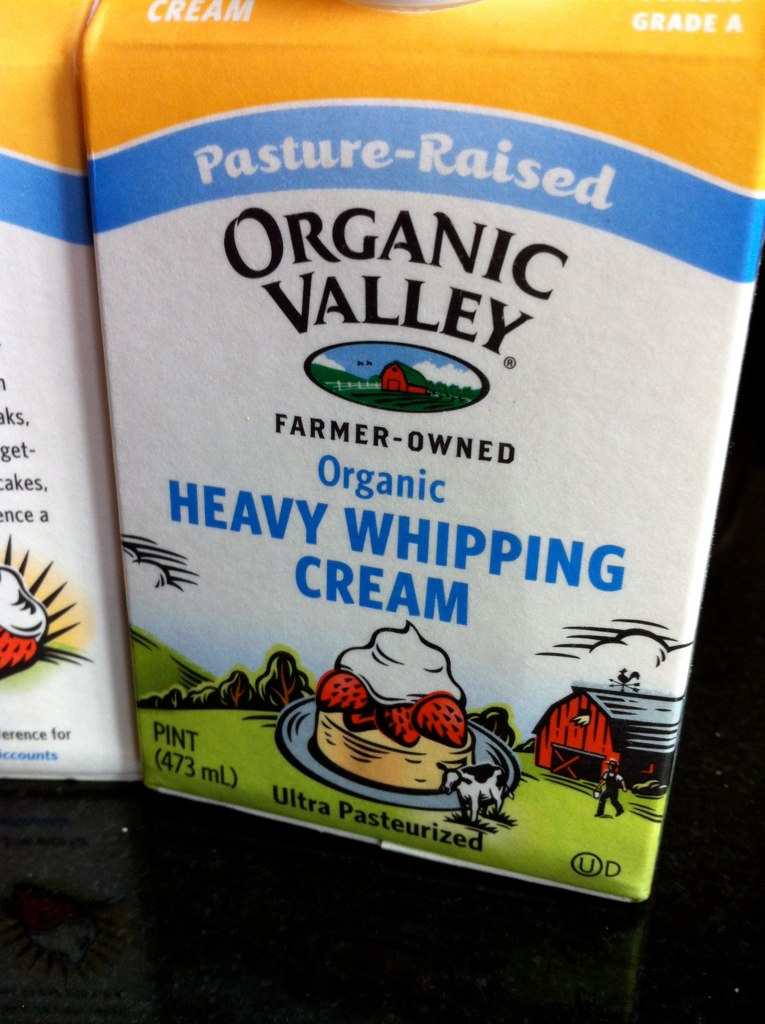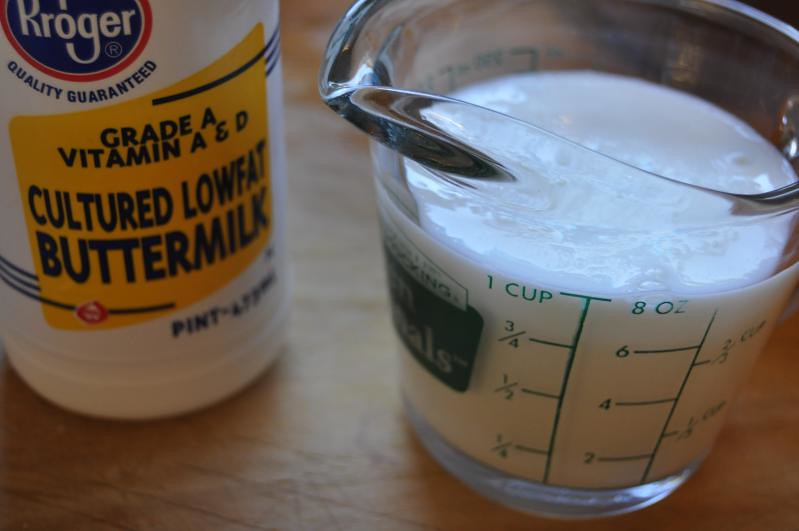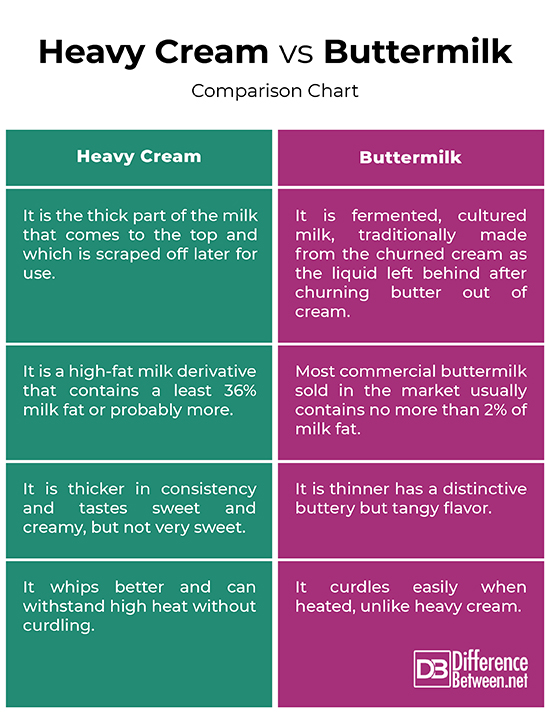Difference Between Heavy Cream and Buttermilk
Why do some recipes call for heavy cream and not the light cream? Can buttermilk be used as a viable substitute for heavy cream? Is whipping cream same as the heavy cream? You need to know what kind of food you’re eating or use them for cooking. This awareness and knowledge of what is what will help you make the right choices because cooking is an art and every art form requires precision. Coming to our topic of the hour, some say buttermilk can be used as a substitute for heavy milk while some say they cannot be used interchangeably because both are very different things. To clarify things for you, we take a look at some basic differences between two of the most important ingredients in baking, among other things.

What is Heavy Cream?
Heavy cream, also goes by thickened cream or heavy whipping cream, is one of the most common and widely used baking ingredients typically made from high-fat, thick part of the fresh milk that rises to the top only to be scraped off later. Creams are naturally characterized by their butterfat content. For a cream to be designated as a whipping cream, it has to be at least 30 percent of fat content. The packaged whipped cream usually says 30 to 35 percent butterfat at the label, while heavy cream consists of about 36 to 40 percent fat content, which is higher than other varieties of cream.
Heavy cream, owing to its higher fat content, tastes richer but also adds the extra fat that everyone is trying to cut down on. From ice creams to pasta sauces to cakes, different recipes call for little to more quantity of heavy cream. First, it whips better because of the high fat content and second, it can stand up to high heat without curdling, making it an ideal ingredient in cakes and chocolates. In fact, heavy cream can be found in a wide variety of cooking regimen, such as biscuits, scones, chowders, soups, salad dressing, pastry fillings, and more.

What is Buttermilk?
Buttermilk is fermented, cultured milk product, similar to natural yogurt, often used in cooking all over the world. Many different cultures around the world have some or other version of this milk that is soured by lactic acid bacteria. But, the buttermilk that you buy in the stores these days is not purely the traditional buttermilk, because it has been pasteurized and homogenized. Traditionally, buttermilk was made from the churned cream; it was the liquid left behind after churning butter out of cream. Today, they are predominantly made by inoculating homogenized, low-fat milk with a lactic acid culture to stimulate the classic buttermilk.
Particularly in India, buttermilk is a classic refreshing summer beverage made with creamy yogurt and seasonings, and mostly called “chaas” in North India. However, it goes by many names in different regions in India. A cheese made from buttermilk called quark is a staple in German, Scandinavian and Eastern European cooking. But remember, buttermilk has higher acid level than milk or cream and it’s thinner, so it curdles easily when heated, unlike heavy cream. Powdered or dried buttermilk, mostly available in canisters, is used mostly for baking.
Difference between Heavy Cream and Buttermilk
Basics
– Heavy cream, sometimes called heavy whipping cream, is the thick part of the milk that comes to the top and which is scraped off later for use. It is made from the high-fat part of the fresh milk and is widely used in cooking, especially baking. Buttermilk, on the other hand, is fermented, cultured milk, similar to natural yogurt, traditionally made from the churned cream as the liquid left behind after churning butter out of cream.
Taste and Texture
– Heavy cream, thanks to its higher fat content, is thicker and has a rich sweet and creamy flavor, but not very sweet, as it does not contain any added sugar. Higher fat creams tend to taste better and have a richer texture. Buttermilk, on the other hand, is thinner in texture and has a distinctive buttery but tangy flavor, and is accompanied by a sour taste.
Fat Content
– Heavy cream is a high-fat milk derivative that contains at least 36 percent milk fat or more. Packaged heavy cream usually consists of about 36 to 40 percent fat content, which is higher than other varieties of cream. Buttermilk, on the other hand, is a low-fat milk product made by inoculating homogenized, low-fat milk with a lactic acid culture to stimulate the classic buttermilk. Most commercial buttermilk sold in the market usually contains no more than 2 percent of milk fat.
Heavy Cream vs. Buttermilk: Comparison Chart

Summary
While both heavy cream and buttermilk are popular milk derivatives used in a variety of cooking regimen, especially baking, heavy cream contains more fat whereas buttermilk has a lower fat content. And because buttermilk is low in fat, it would be difficult to make whipped cream from buttermilk alone. Some recipes call for high fat, so buttermilk cannot be used as a substitute for heavy cream in such recipes. Buttermilk is mostly used as a flavoring agent whereas heavy cream is used in a wide variety of recipes, from ice creams to cakes to chowders, pastries and biscuits.
- Difference Between Caucus and Primary - June 18, 2024
- Difference Between PPO and POS - May 30, 2024
- Difference Between RFID and NFC - May 28, 2024
Search DifferenceBetween.net :
1 Comment
Leave a Response
References :
[0]Image credit: https://live.staticflickr.com/3523/4075663345_6091b24f44_c.jpg
[1]Image credit: https://live.staticflickr.com/7223/6871527128_3768ce7a2f_b.jpg
[2]Allen, Terese. The Ovens of Brittany Cookbook. Wisconsin, United States: The Guest Cottage, Inc., 1991. Print
[3]St. Clair, Diane. The Animal Farm Buttermilk Cookbook: Recipes and Reflections from a Small Vermont Dairy. Missouri, United States: Andrews McMeel Publishing, 2013. Print
[4]Moose, Debbie. Buttermilk: a Savor the South Cookbook. North Carolina, United States: University of North Carolina Press, 2012. Print
[5]Nosrat, Samin. Salt, Fat, Acid, Heat: Mastering the Elements of Good Cooking. New York, United States: Simon and Schuster, 2017. Print

Good job